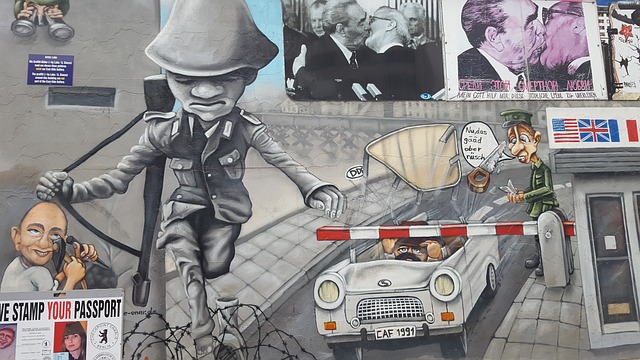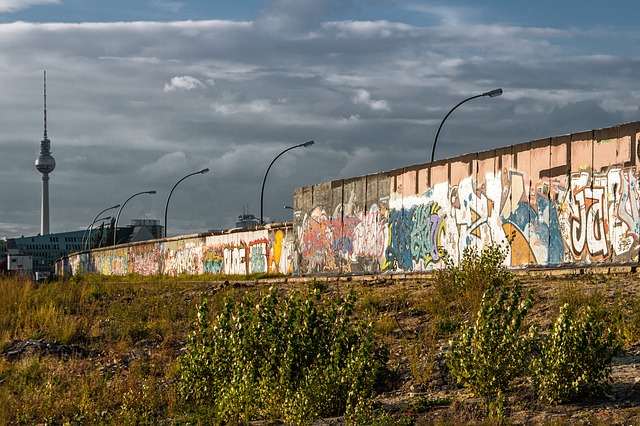
From January 1983, the GDR border troops start building new observation towers on the Berlin Wall. The new type is square (4.2 × 4.2 m). It was assembled from prefabricated concrete elements. There are four storeys inside. Nevertheless, the tower measures only about ten metres in height. On the upper storey there are shooting hatches that are clearly visible from the outside. The roof was accessible and served to set up the well-known searchlights.
The base floor is sunk into the ground. Technical installations and lines as well as telephone connections to the other surrounding observation towers were housed here. The entrance door leads to the ground floor, with a (men’s) toilet and a precautionary holding cell. The first floor was reserved for the commandant, usually a non-commissioned officer for three guards. Already on the first floor, all four sides were equipped with large panoramic windows: the actual observation post with full all-round visibility.

The electrical control panel for monitoring the border installation was impressive in 1983. The switch lever for operating the searchlight was also located here on the roof. The individual storeys were connected by trapdoors and steep iron stairs. Actually, this type of watchtower was not specially developed for the Berlin Wall. The third storey had the shooting hatches already mentioned, although in Berlin they were closed with iron flaps. This small room was used as a recreation room for the border guards, so the shooting hatches had no function. If the worst came to the worst, they would have had to shoot from the roof. Allegedly, the watchtower was probably developed to secure the Soviet-Chinese border.
But since the interested viewers of the Berlin Wall could not yet know such things, the shooting hatches were all the more impressive! Just as a visit to the East Side Gallery (and hopefully the Wall Museum!!) is part of the programme for tourists to Berlin today, before the “fall of the Wall” it was viewing platforms from which one could look into the border area at regular intervals along the Berlin Wall.
The watchtower described has survived, for example, in the Treptow district, about 15 minutes’ walk southwest from The Wall Museum. Walk across the Oberbaumbrücke bridge into Kreuzberg and keep left on Schlesische Straße for about a thousand metres. After crossing the Landwehrkanal at the bridge, the martial tower stands lonely in the Schlesischer Busch on the right. It is worth a visit, if only because the Flutgraben Association has an exhibition on the history of the Berlin Wall in this area. There are also changing art exhibitions, especially in summer.

This tower has been a listed building since 1992. The state of preservation is very good. Even before the final and official abandonment of border security between East and West Berlin on 1 July 1990, the former Museum of Forbidden Art committed to it. In 2004, the building was carefully restored in keeping with its status as a listed building. The Berlin State Monuments Office notes: “The conservation measures financed by the Federal Employment Agency, the State of Berlin and the Treptow-Köpenick District Office were not intended to restore the building to a new state, but to conserve the condition that had developed over the decades and to halt further decay. That is why not all existing damage or graffiti has been removed. In the interior, the last paint that is known to exist has been renewed.
Another example of these watchtowers has been preserved in the so-called Kieler Eck, in the Mitte district near the Invalidenfriedhof and directly on the Spandauer Schifffahrtskanal. It does not stand lonely in the landscape, but is surrounded by many new buildings that have been erected on the former Wall sites. So it is not so easy to find the tower today.
Since August 2003, the brother of one of the first people to die at the Wall has been running a memorial in the watchtower. The 24-year-old Günter Litfin (https://de.wikipedia.org/wiki/Günter_Litfin)
was shot while swimming in Humboldt Harbour very close to the guard tower on 24 August 1961, eleven days after the barrier measures were put in place. He was to be followed by other victims, especially in the Spree area, which the Wall Museum commemorates on its unique balcony. Incidentally, Günther Litfin came from the Hohenschönhausen district of the then Berlin borough of Weißensee. When he grew up there, the social environment was essentially shaped by the GDR’s State Security Service, which was based here in a special way (https://www.pw-portal.de/rezension/19720-in-den-villen-der-agenten_22953). His brother Jürgen Litfin, who stayed in Weissensee after his brother’s death, knows stories of a very special kind from everyday life in the GDR…
Incidentally, an identical watchtower was located after 1983 in the border area between Glienicke/Nordbahn and Berlin-Hermsdorf. Just across the street, the Aagaard family had a plot of land in Ottostraße. From their house, this family dug a tunnel under the Berlin Wall and fled to the western part of Berlin in March 1963. (http://fluchttunnel-glienicke.de/page9/page5/). Archaeologist Torsten Dressler also came across the base area of the former watchtower during excavations for the escape tunnel and professionally recorded the traces of the disgusting infrastructure.



